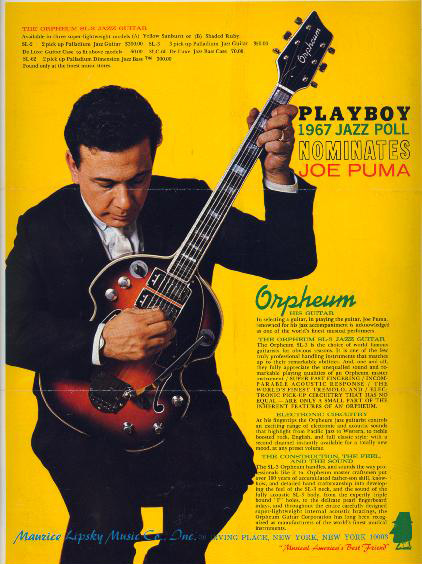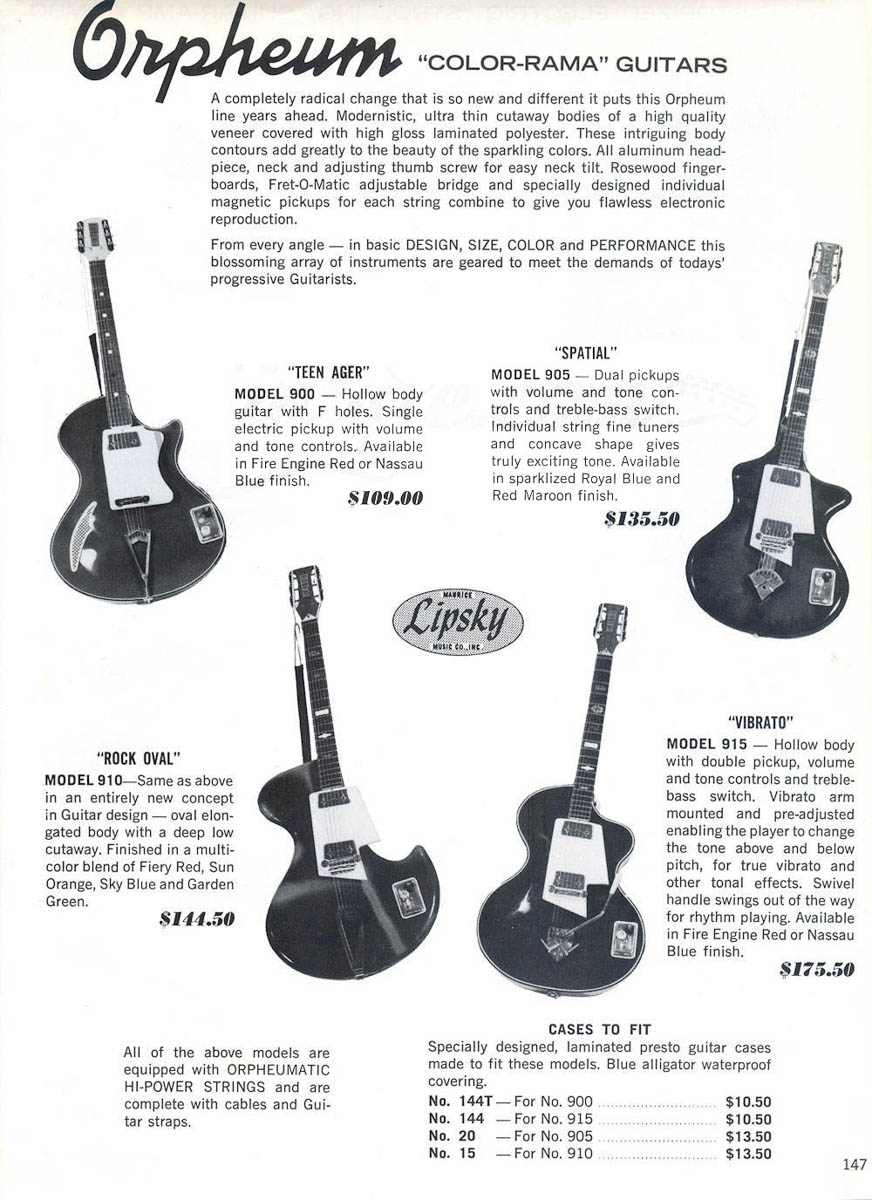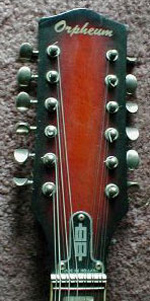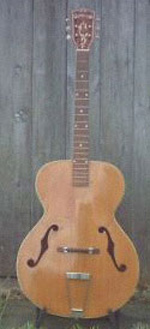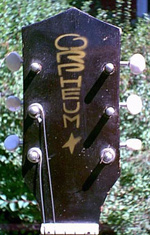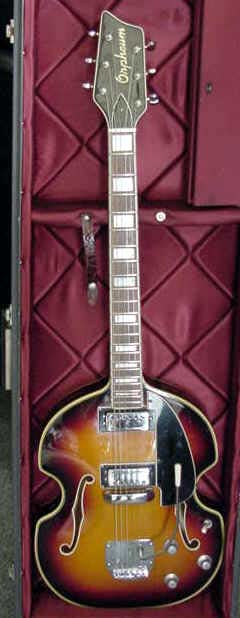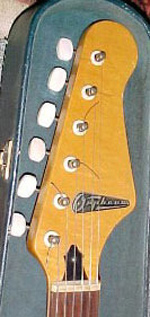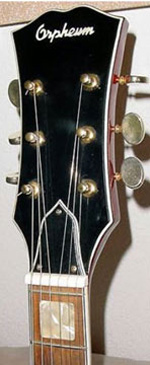OrpheumMaurice Lipsky
by Jack Marchal
The Orpheum brand was used already in the late 19th century by an American banjo maker. In the 1930’s the company began marketing acoustic then archtop jazz guitars and even wind instruments but that business ceased during WW-II.
By the end of the war the trade name was recycled by the Maurice Lipsky Music Co., Inc. of New York for a range of stringed instruments, positioned in the same market segment as Kay, e.g. affordably priced average quality. Hollow-bodies from that era with a Orpheum logo appear from time to time on the U.S. vintage market, they surely do not compare to Gretsches or Gibsons but own a specific post-war or early 50’s charm all the same.
In the early 60’s, as the electric guitar turned out to be a mass market product, Orpheum stopped selling American made instruments and began importing cheap European instruments made by Wandré. “Cheapness“ today is not the predicate that readily associates with Wandré, but back then a Tri-Lam was barely seen as low-cost Italian junk, a plastic and aluminum imitation of the real thing. Due to their avant-garde construction and manufacturing process some Wandré guitars were actually among the most inexpensive available. Times have changed since then!…
In addition to the Tri-Lam, Lipsky also distributed weirder Wandré models, even the Rock Oval. A culture shock after the traditionally crafted Orpheum archtops of the previous decade.
After Wandré the Orpheum logo was applied to the absolutely cheapest (surely not the best) guitars Europe had to offer, i.e. Egmond archops. The agreement with the Dutch maker lasted approx. from 1963 to 1967. Meanwhile the distribution program was widened with low-end generic Japanese solid-bodies supplied by Guyatone. Orpheum was back then just a second-rate brand behind Lipsky’s mainstay, the Domino range with its gorgeous MIJ Vox teardrop and Phantom copies.
In 1967-68, with the growing trend favoring more serious guitars, Orpheum tried to regain a higher status and entered a short-lived cooperation with the Welson Co. for distribution in the U.S. of their range of violin-shaped guitars. No much is known on the matter, other than this agreement took place after the one with Wurlitzer was terminated. At the same time the whole range of Welson electric guitars was also distributed in America under the Welson brand — except for the fiddle-shaped ones.
In the early seventies Orpheum was importing Japanese-made Gibson knockoffs of pretty decent quality, maybe sourced from the same facilities where Ibanez SG and LesPaul copies were crafted. There is no further record of any Orpheum activity.
Italiano
Già alla fine dell’Ottocento il marchio Orpheum era usato da un costruttore americano di banjo. Negli anni ’30 la ditta iniziò a commercializzare chitarre jazz e anche strumenti a fiato ma questa attività si fermò durante la Seconda Guerra Mondiale.
Nel dopoguerra la marca venne rilevata dal distributore Maurice Lipsky, a New York, per una gamma di strumenti a corda posizionati nello stesso segmento di mercato di Kay, cioè qualità media abastanza economica. Si trovano ogni tanto sul mercato americano del vintage chitarre jazz di quell’epoca, che sicuramente non sono da confrontare con le Gretsch o le Gibson ma che hanno il fascino specifico del dopoguerra o dei primi anni ’50.
All’inizio degli anni ’60, allorché la chitarra elettrica diventa un prodotto di massa, Orpheum smette la vendita di strumenti fatti in USA e incomincia a importare dall’Europa roba economica fatta da Wandré. “Economica” oggi è una parola che mal si associa con la produzione di Wandré, ma una Tri-Lam allora era vista come una sorta di paccottiglia italiana, l’imitazione in plastica e alluminio di una vera chitarra… Grazie alla loro concezione e a processi di produzione d’avanguardia certe Wandré erano realmente fra le più economiche disponibili. Era un’altra epoca!…
Oltre la Tri-Lam, Lipsky ha anche distribuito modelli Wandré più bizzarri come la Rock Oval. Choc culturale dopo le archtops tradizionali del precedente decennio.
Dopo Wandré il marchio Orpheum venne applicato alla roba più economica in assoluto (di certo non la migliore) che si poteva trovare in Europa — le archtops di Egmond. L’accordo con il produttore olandese durò più o meno dal 1963 al 1967. Nel frattempo Orpheum allargò il programma di vendita includendo solid-bodies giapponesi generiche fornite da Guyatone. Orpheum era allora diventato un marchio di secondo ordine dietro il cavallo di battaglia di Lipsky, il brand Domino e le sue splendide copie giapponese di Vox teardrop e Phantom.
Nel 1967-68, con la tendenza crescente a favore degli humbuckers e di chitarre più serie, Orpheum tentò di risollevare la qualità dei suoi strumenti ed ebbe una breve cooperazione con Welson per distribuire in USA la sua gamma di chitarre violino. Non si sa molto sulla vicenda, salvo che questo accordo venne concluso dopo la fine di quello firmato con Wurlitzer. Allo stesso tempo tutta la gamma Welson era distribuita in America anche sotto il proprio marchio Welson — eccezione fatta di quelle a sagoma di violino.
All’inizio degli anni 70 Orpheum importò copie giapponesi di modelli Gibson, di qualità discreta, forse provenienti dalle stesse officine che duplicavano le SG e LesPaul per Ibanez. E poi il nome Orpheum non si fa più sentire.

